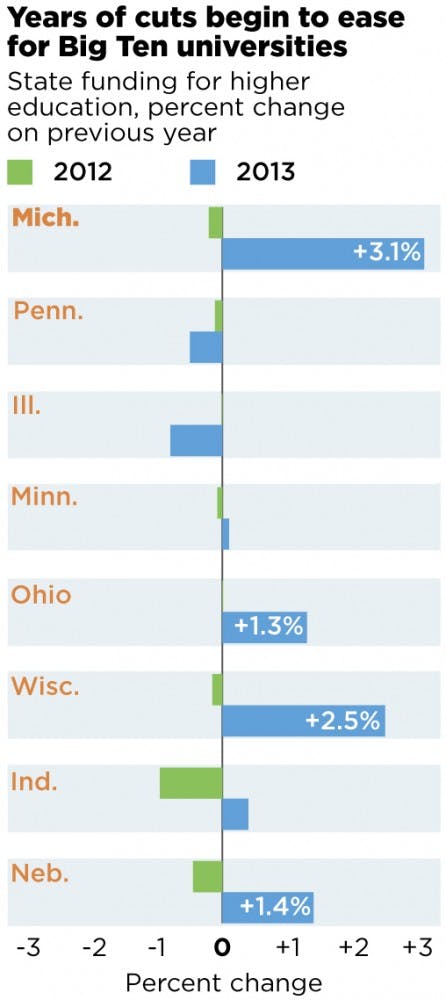After years of cuts, state funding to Michigan universities could be on the rise.
A recent study shows Michigan universities received more state appropriations in the past year, but university officials doubt this trend will continue.

After years of cuts, state funding to Michigan universities could be on the rise.
A recent study shows Michigan universities received more state appropriations in the past year, but university officials doubt this trend will continue.
This fiscal year, Michigan colleges and universities received a 3.1 percent increase in state funding compared to massive cuts in recent years, according to the Grapevine survey featuring research collected by Illinois State University.
MSU College of Education Dean Donald Heller said state appropriations to higher education likely are increasing in correlation with Michigan’s increasing revenue.
“When state budgets contract, higher education is generally one of the first parts of the budget to get cut,” he said. “As state budgets grow, higher education tends to get more money.”
When Michigan was at one of its lowest economic periods, Gov. Rick Snyder cut 15 percent of state appropriations toward higher education for the 2011-2012 fiscal year.
But a year later, he allocated about $299 million to MSU for the 2012-13 fiscal year, a slight increase compared to last year’s $284 million appropriation.
Higher, Adult and Lifelong Education assistant professor Brendan Cantwell said higher education historically experiences some return in funding after recessions, but Michigan universities shouldn’t expect the trend to continue.
Instead, Snyder placed a higher emphasis on performance metrics to determine funding, Cantwell said. The metrics measure a range of variables, such as how effectively the university increases graduation rates, how many students earn Pell Grants and how many students are enrolled in science, technology, engineering and math, or STEM, fields.
“I think that members of the state Legislature feel that they need to provide incentives for colleges and universities to engage in (these) particular actives,” Cantwell said.
State Rep. Sam Singh, D-East Lansing, and former East Lansing mayor, recently was appointed to Michigan’s House Appropriations Committee and was appointed as vice chair of the Higher Education and Education subcommittee, potentially increasing MSU’s political sway when the time comes to pass a budget.
When compared to the national average, Michigan students receive about $2,000 less per student in state funding, according to Grapevine research.
“The state needs to reinvest in higher education if it wants to see more students attaining postsecondary education credentials,” Heller said. “Otherwise, tuition will continue to rise at rates that will price many students out of attending college.”
Cantwell said universities typically are one of the first areas to experience budget cuts because they can raise revenue by increasing tuition, whereas public bodies such as police departments or K-12 schools cannot.
To increase funding, the MSU Board of Trustees approved a 3.5 percent increase in tuition for in-state students and a 5 percent increase for out-of-state students for the 2012-13 academic year. Although state appropriations to universities increased this year, Cantwell said students shouldn’t expect tuition to decrease.
While Evan Martinak, president of ASMSU — MSU’s undergraduate student government — understands legislators have to pick and choose what they spend money on, he said cutting higher education funding could hurt the economy in the long run.
“If we want to draw that kind of financial capital, we need to invest first in our human capital,” he said.
Support student media! Please consider donating to The State News and help fund the future of journalism.